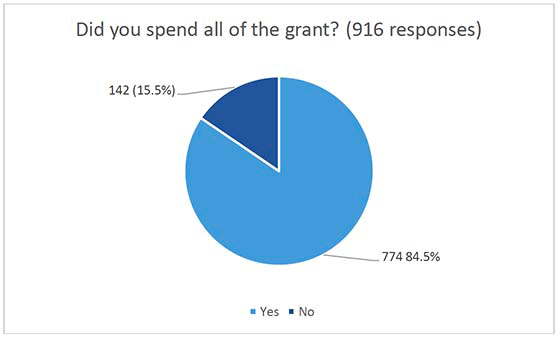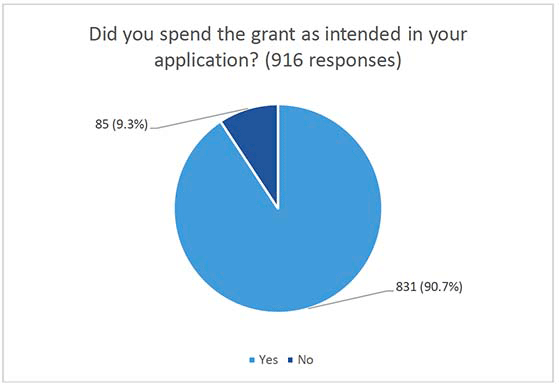Wellbeing Fund - open application process: evaluation
Evaluation of the Wellbeing Fund open applications process, an emergency funding programme set up in March 2020 to support the third sector response to the coronavirus pandemic.
4. Was the funding used as intended?
4.1 Was all the funding spent within the designated funding period?
Only projects designed to last no longer than three months were eligible for funding. In the end-of-project monitoring form, Wellbeing Fund recipients were asked whether they had spent their entire grant award. As shown in Figure 8, 916 organisations responded to this question, with 774 (84.5%) confirming that they had spent all of the funding. The remaining 142 (15.5%) organisations had not spent it all by the time they completed the monitoring form.

Of the 142 organisations that had not spent the full grant amount, 50 (35.2%) did not specify a reason for this. It is expected, however, that many of these organisations may not have come to the end of their grant period by the time they completed the monitoring form.
Of the remaining 92 organisations that did specify a reason for not having spent the full grant amount, over a quarter of organisations (26.1%) said that it was because their costs were lower than they had anticipated when applying for the grant.
Table 2: Reason for not spending full grant amount (organisations that specified a reason (92))
| Reason for not spending grant in full | Number | Percentage |
| Costs lower than expected | 24 | 26.1 |
| Unable to implement project in full/low demand for project | 19 | 20.7 |
| Project slower than expected | 13 | 14.1 |
| Still in funding period | 10 | 10.9 |
| Awaiting goods/invoice from provider | 9 | 9.8 |
| Received food donations/funding from elsewhere | 8 | 8.7 |
| Unable to hire staff/staff absence | 5 | 5.4 |
| Other | 4 | 4.3 |
| Total | 92 | 100 |
The second most common reason was that organisations had been unable to implement their project in full and/or demand for their project was low. A further 14.1% said that the project had progressed more slowly than anticipated. In several cases this was explained as being due to delays in supply chains and restrictive social distancing measures.
9.8% of projects were awaiting final deliveries and/or invoices from suppliers to complete their spending, and 8.7% of organisations – mostly those providing food – had not spent their full grant either because they had also received other grants, or they had received large donations of food and essential items from private businesses or the general public, therefore reducing their need for spending on food. A further 10.9% of organisations had not spent the grant in full because they had not yet come to the end of their funding period.
4.2 Was the funding used as intended?
Organisations were asked whether they used the grant funding as they had stated they would in their original applications. As Figure 9 indicates, 916 organisations responded to this question, with 831 (90.7%) saying that the grant had been used as originally intended, while 85 (9.3%) reported that its use had changed.

There were a variety of reasons for organisations not using the funds exactly as intended. Changes to anticipated demand were a common reason, with organisations often reporting deciding to change their service provision as a result of higher demand than anticipated, lower demand than anticipated, new unanticipated needs emerging as priorities among service users, or becoming aware of significant needs among people outside their original target groups.
Operational changes and challenges also led to some organisations changing their use of the funding. These reasons included projects moving more slowly than expected, organisations struggling to source items listed in their original budgets – often as a result of supply-chain lags as a result of the pandemic – and organisations spending less than they had budgeted for on some of their costs.
Overall, then, the data suggests that the majority of funding provided by the Wellbeing Fund was used for the purposes it was originally intended fo, based on the information organisations provided in their application forms. Similarly, most of the funding was spent within the designated funding period. Where these were not the case, in most cases it appears to have been as a result of unanticipated changes in circumstances.
Contact
Email: socialresearch@gov.scot
There is a problem
Thanks for your feedback